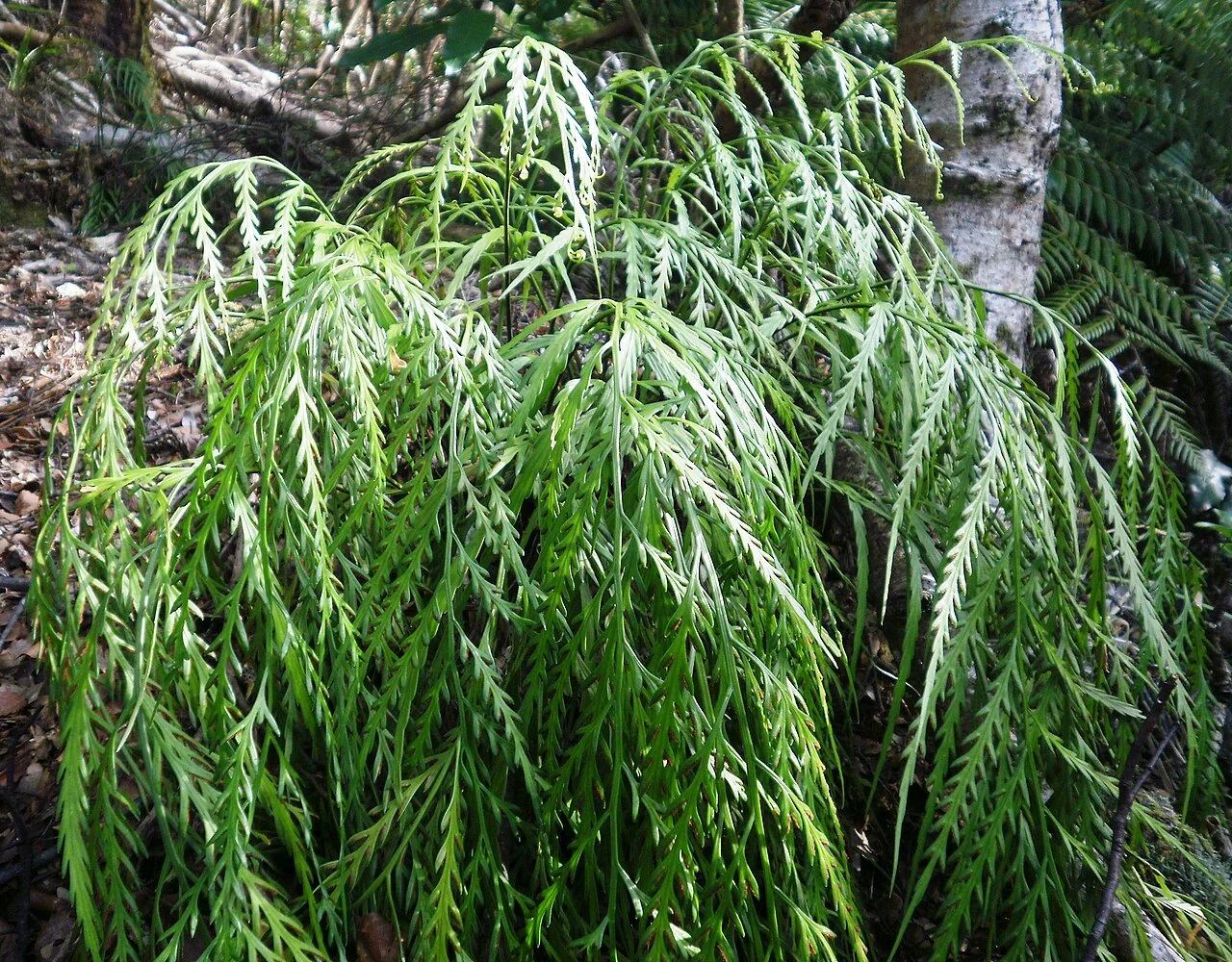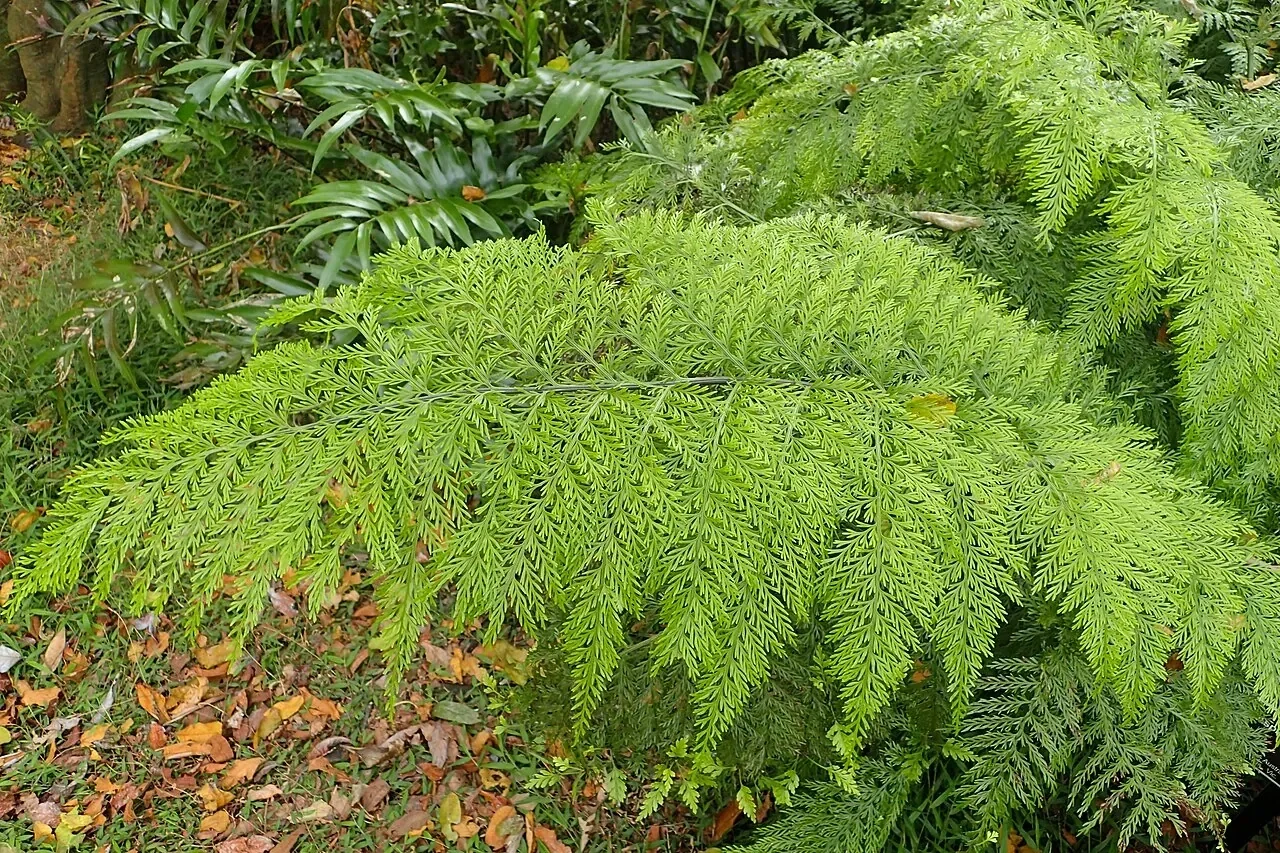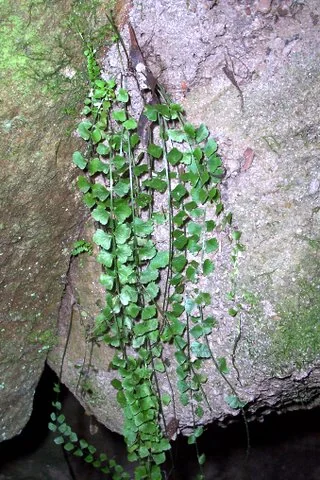
Drooping Spleenwort
Asplenium flaccidum
Explore more NZ native plant guides in our index .
Introduction
About Drooping Spleenwort
Asplenium flaccidum , commonly known as Drooping Spleenwort or Makawē, is a distinctive native fern of New Zealand. It is characterized by its long, leathery, drooping fronds that can grow up to 1 meter in length. This fern often grows as an epiphyte on trees or as a lithophyte on rocks, particularly in damp, shady forest environments.

Plant Description
Physical Characteristics
Drooping Spleenwort ( Asplenium flaccidum ) is a distinctive and graceful fern, highly valued for its long, pendulous fronds that give it a weeping appearance. It can grow as a terrestrial fern, but is more commonly found as an epiphyte (growing on trees) or a lithophyte (growing on rocks).
The fronds are typically 30-100 cm long, but can sometimes reach up to 2 meters in length, and are dark green, leathery, and somewhat fleshy. They are bipinnate to tripinnate (divided two or three times), with narrow, linear pinnae (leaflets) that are often deeply lobed or toothed. The texture of the fronds is firm and somewhat brittle when dry, but flexible when moist.
The stipes (stalks) are dark, shiny, and covered with small, dark scales at the base. The sori (spore-producing structures) are linear and arranged along the veins on the underside of the pinnae, becoming prominent when mature.
This fern is evergreen in most climates, providing year-round interest. Its ability to grow in various forms, terrestrial, epiphytic, or lithophytic - showcases its adaptability to diverse microhabitats within its native range.
Quick Facts
Plant Summary
| Scientific Name | Asplenium Flaccidum |
|---|---|
| Height | 30-100 cm |
| Spread | 30-60 cm |
| Water Needs | Moderate to high; prefers consistently moist conditions |
| Light | Partial to full shade |
| Frost Tolerance | Moderate |
| Salt Tolerance | Low |
| Growth Rate | Moderate |
| Lifespan | Perennial |
Climate Best Suited to
Asplenium flaccidum is found throughout New Zealand in lowland to montane forests. It thrives in a mild, humid climate with consistent moisture and protection from strong winds and direct sunlight.
Regional Suitability
| Whangārei | Ideal |
| Auckland | Ideal |
| Hamilton | Suitable |
| Rotorua | Suitable |
| Tauranga | Ideal |
| Gisborne | Ideal |
| New Plymouth | Ideal |
| Whanganui | Ideal |
| Palmerston North | Suitable |
| Napier | Ideal |
| Wellington | Ideal |
| Nelson | Ideal |
| Christchurch | Suitable |
| Dunedin | Suitable |
| Invercargill | Suitable |
| City | Climate Suitability |
|---|
Natural Habitat
Native Environment and Distribution
Drooping Spleenwort ( Asplenium flaccidum ) is endemic to New Zealand, where it is widespread throughout the North, South, and Stewart Islands, and also found on some offshore islands. It is a highly adaptable fern, found in a variety of habitats from coastal areas to montane forests.
- Epiphytic Growth: Most commonly, Asplenium flaccidum grows as an epiphyte, attaching itself to the trunks and branches of native trees such as rimu, tawa, and beech. It uses its roots to anchor itself and absorb moisture and nutrients from the air and decaying organic matter accumulating on the host tree.
- Lithophytic Growth: It also frequently grows as a lithophyte, rooting into crevices and cracks on rocks, cliffs, and boulders, particularly in shaded and damp locations.
- Terrestrial Growth: Less commonly, it can be found growing terrestrially on the forest floor, especially in very damp, humus-rich soils in sheltered areas.
- Forest Environments: It thrives in damp, shady lowland to montane forests, where high humidity and protection from direct sunlight are prevalent. It is a common component of the understory vegetation.
- Coastal to Montane: Its altitudinal range is considerable, from sea level up to around 1000 meters, showcasing its broad adaptability to different temperature and moisture regimes within New Zealand.
The ability of Drooping Spleenwort to occupy multiple ecological niches (epiphytic, lithophytic, and terrestrial) highlights its resilience and contributes to its widespread distribution across New Zealand's diverse natural landscapes.
Plant Conservation
Threats and Efforts
Drooping Spleenwort ( Asplenium flaccidum ) is a widespread native New Zealand fern with a national conservation status of "Not Threatened." This classification reflects its broad distribution across the North, South, and Stewart Islands, as well as its presence in Australia and other Pacific regions.
Its adaptability to various habitats, from coastal to montane forests, and its ability to grow as an epiphyte, lithophyte, or terrestrially, contribute to its secure status. While not facing immediate national threats, local populations can be impacted by habitat degradation, deforestation, and changes in humidity levels due to environmental shifts. Conservation efforts focus on protecting its natural forest environments, particularly maintaining the integrity of damp, shady areas where it thrives. Its resilience and widespread nature make it a valuable component of New Zealand's biodiversity, and its continued presence is supported by the preservation of healthy native ecosystems.
Growing Requirements
Soil Requirements
Prefers moist, well-drained, humus-rich soil. When grown as an epiphyte, it requires a substrate that retains moisture.
Light Requirements
Thrives in partial to full shade. Avoid direct sunlight, which can scorch the fronds.
Water Requirements
Requires consistent moisture, especially during dry periods. Do not allow the substrate to dry out completely.
Planting Guide
-
When to Plant
Plant in autumn or spring.
-
Site Preparation
Choose a shady site with moist, well-drained, humus-rich soil.
-
Planting and Aftercare
Dig a hole twice the width of the root ball. Place the fern in the hole, ensuring the crown is level with the soil surface. Backfill with soil and water thoroughly. Apply a layer of mulch.
Ecological Role
Native Ecosystem Importance
Drooping Spleenwort ( Asplenium flaccidum ) plays a significant ecological role in New Zealand's native forests, particularly due to its epiphytic and lithophytic growth habits.
- Epiphytic Niche: As a prominent epiphyte, it occupies a unique niche in the forest canopy and understory, growing on trees and utilizing the moisture and nutrients available in the air and from decaying organic matter. This reduces competition with terrestrial plants and contributes to the vertical stratification of the forest ecosystem.
- Lithophytic Role: Its ability to thrive on rocks and cliffs helps to colonize bare surfaces, contributing to soil formation over time as organic matter accumulates around its root system.
- Humidity Regulation: The dense growth of its fronds contributes to maintaining high humidity levels in the immediate microenvironment, which is crucial for other moisture- loving organisms, including other ferns, mosses, and invertebrates.
- Habitat Provision: The fronds and root masses of Asplenium flaccidum provide shelter and microhabitats for a variety of small invertebrates, including insects, spiders, and snails, which in turn can be a food source for birds and other forest fauna.
- Water Interception: Its fronds are effective at intercepting rainfall and fog, directing moisture down to its root system and contributing to the overall water cycle within the forest ecosystem.
The ecological contributions of Drooping Spleenwort highlight its importance in supporting the biodiversity and health of New Zealand's unique forest environments.
Uses and Significance
Garden Uses
- An excellent fern for shady borders, woodland gardens, rockeries, and containers.
- Its drooping fronds add a graceful touch to any shaded area.
Cultural Significance
Traditional Uses and Values
The fronds of Drooping Spleenwort ( Asplenium flaccidum ) were traditionally used by Māori for weaving and creating decorative items. The plant was also used in rongoā (traditional Māori medicine) for various ailments.
Landscaping Applications
Design and Application
Drooping Spleenwort ( Asplenium flaccidum ) is a highly prized fern in landscaping due to its unique drooping habit and adaptability to various growing conditions, making it suitable for a range of garden designs.
- Epiphytic Displays: Its natural epiphytic growth makes it an excellent choice for attaching to tree trunks, logs, or specialized fern trees in shaded, humid gardens. This creates a naturalistic, forest-like aesthetic and adds vertical interest.
- Hanging Baskets and Containers: The long, pendulous fronds are perfectly suited for hanging baskets, where they can cascade gracefully, creating a stunning visual display. It also thrives in pots and containers, allowing for flexible placement in shaded patios, verandas, or indoors.
- Shade Gardens and Woodland Settings: As a terrestrial fern, it can be used as a groundcover or accent plant in damp, shaded borders, woodland gardens, or alongside streams and ponds. Its leathery fronds provide year-round texture and colour.
- Rock Gardens: Its lithophytic tendencies mean it can be successfully grown in rock gardens, nestled into crevices where moisture is retained, adding a touch of natural elegance to stone features.
- Underplanting: It serves as an excellent underplanting for larger native trees and shrubs, creating a lush, multi-layered effect that mimics natural forest environments.
When incorporating Drooping Spleenwort into your landscape, ensure it receives consistent moisture and protection from direct sun and strong winds to maintain its health and characteristic beauty.
Seasonal Care Calendar
Spring
- Apply a layer of compost or leaf mould to enrich the soil and retain moisture.
Summer
- Water regularly, especially during dry periods.
Autumn
- No special care required.
Winter
- Protect from heavy frosts in colder regions.
Pruning and Maintenance
Frond Care
Remove any old, damaged, or yellowing fronds as needed to maintain the graceful drooping appearance that defines this species. Monitor for slug, snail, and aphid damage, treating promptly when evident. Be vigilant for scale and mealy bug infestations which commonly affect New Zealand Asplenium species. The thick, leathery fronds are naturally long and drooping, so avoid trimming healthy fronds that contribute to the characteristic weeping form.
How to Grow Drooping Spleenwort
Spores
Spore propagation is the primary natural reproduction method for Drooping Spleenwort, utilizing the minute spores that are naturally wind-dispersed from mature plants in forest environments. This epiphytic fern produces spores that are notably smaller than those of related species, requiring careful collection and handling techniques for successful propagation. The optimal timing for spore collection is during late summer to autumn when the sori (spore clusters) on the undersides of mature fronds have ripened from green to brown, indicating spore maturity. Unlike some ferns, Asplenium flaccidum can be variable in its spore production, so monitor multiple plants to identify the best specimens for collection. To collect spores, cut healthy fronds with brown sori and place them in clean paper bags or envelopes, storing them in a warm, dry location for several days to allow natural spore release. The released spores appear as fine, dust-like particles that should be sown immediately for optimal germination rates. Prepare a sterile growing medium using a mixture of finely chopped sphagnum moss, peat moss, and perlite, sterilizing with boiling water and allowing to cool completely. Sow spores thinly on the moist surface and cover containers with glass or clear plastic to maintain high humidity levels essential for germination. Maintain consistent temperatures between 18-22°C with bright, indirect light, ensuring the growing medium remains consistently moist but not waterlogged. Germination is typically slow and irregular, taking several weeks to months for the initial prothallus stage to develop, followed by many additional months for recognizable fern sporophytes to emerge. The young plants require careful attention to humidity and light levels throughout their development, making this method more suitable for experienced fern enthusiasts rather than casual gardeners.
Division
Division offers a more reliable and faster propagation method for Drooping Spleenwort, though it requires careful handling due to the epiphytic nature and specific growing requirements of this distinctive fern. While typically growing as an epiphyte in forest environments, cultivated specimens often develop sufficient root systems that allow for successful division when grown in containers or suitable garden locations. The optimal timing for division is during spring when new growth is beginning to emerge, providing the best opportunity for rapid establishment of divided sections. Begin by carefully removing the plant from its growing medium, whether in containers or from naturalistic garden settings where it has established. Drooping Spleenwort develops a crown-forming growth habit with multiple growing points that can be separated, though the root system is typically less extensive than terrestrial ferns. Gently tease apart the root mass to identify natural divisions where separate crowns have developed, using clean, sharp knife if necessary to cut through any connecting rhizomes. Each division should include both healthy roots and at least one active growing point with visible fronds or emerging shoots. Due to the epiphytic nature of this species, divisions are often smaller and more delicate than those of ground-dwelling ferns, requiring extra care during handling and establishment. Replant divisions immediately in a well-draining, organic-rich growing medium that mimics forest floor conditions, such as a mixture of bark chips, leaf mold, and sphagnum moss. Provide consistent moisture without waterlogging, high humidity, and protection from direct sunlight during the establishment period. This method works particularly well for container cultivation, hanging baskets, and specialized fern gardens where the distinctive drooping growth habit can be showcased effectively. Success rates are generally good with proper care, though establishment can be slow as mentioned in cultivation notes, requiring patience and consistent environmental conditions.
Container Cultivation
Container cultivation represents the most practical approach for most gardeners wanting to grow Drooping Spleenwort, taking advantage of its excellent suitability for pot and hanging basket culture while providing controlled growing conditions that ensure success. This method effectively bypasses the challenges of spore propagation and division by starting with nursery-grown plants that are already established and adapted to cultivation. Drooping Spleenwort is recognized as an excellent container plant due to its naturally epiphytic growth habit and tolerance for the restricted root environments that containers provide. Choose containers with excellent drainage, such as hanging baskets, orchid pots, or standard containers with multiple drainage holes, as waterlogged conditions can quickly damage the root system. Use a specialized growing medium that replicates forest epiphyte conditions, combining bark chips, sphagnum moss, leaf mold, and perlite in proportions that provide both moisture retention and rapid drainage. Position containers in locations that receive bright, indirect light throughout the day, avoiding direct sunlight that can scorch the delicate fronds. The natural drooping growth habit makes this fern particularly attractive in hanging positions where the long, graceful fronds can cascade freely. Maintain consistent moisture levels without allowing the growing medium to become waterlogged, and provide additional humidity through misting or humidity trays, especially in indoor environments. Regular feeding with diluted liquid fertilizer during the growing season supports healthy development, while the relatively slow growth rate means repotting is only needed every 2-3 years. This approach allows gardeners to enjoy the distinctive beauty of this native epiphyte without the technical challenges of propagation, while also providing flexibility to move plants to optimal positions as seasonal conditions change. Container-grown specimens often thrive for many years with proper care and can eventually be used as source plants for division or spore collection as they mature.
Pests and Diseases
Scale Insects
Hanging Spleenwort is generally robust but can be prone to scale insects, especially in drier or indoor environments. These look like small brown bumps on the stems. Improve humidity and airflow, and treat persistent infestations with neem oil.
Bonus Tip
Creating an Epiphytic Display
To truly showcase the natural beauty and epiphytic habit of Drooping Spleenwort ( Asplenium flaccidum ), you can actively encourage its spread in your garden.
Choose a piece of untreated wood, such as cork bark or a section of a fallen branch. Secure the fern to the wood using fishing line or floral wire, ensuring its roots are in contact with the bark. You can add a small amount of sphagnum moss around the roots to help retain moisture. Hang the mounted fern in a shaded, humid location, misting it regularly. This method not only mimics its natural growth but also creates a stunning, living art piece for your garden or indoor space.







